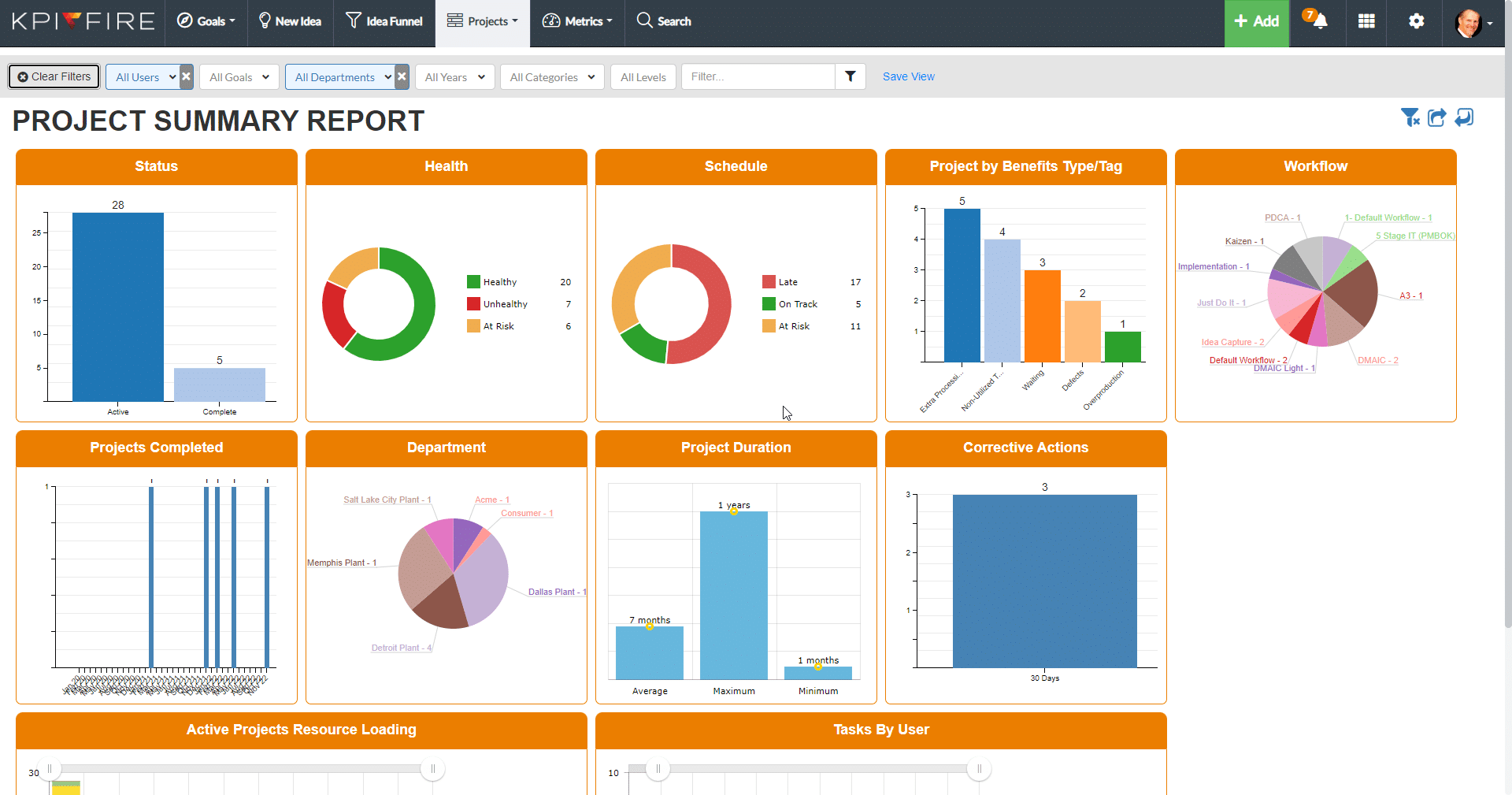This article delves into the significance of strategic project management (SPM), highlighting how it ensures that projects and processes align with an organization’s strategic goals and objectives. It discusses the benefits of this approach, while highlighting KPI Fire as a critical tool to catapult strategic planning by aligning projects with strategic goals and monitoring performance.
Introduction to Strategic Project Management
Strategic project management is a disciplined approach to planning, executing, and controlling projects that align with an organization’s overall strategic objectives. It involves a systematic process of defining project scope, setting clear goals, allocating resources, and managing risks to ensure successful project completion.
Understanding Strategic Project Planning
Strategic project planning is a critical component of successful project management. It involves a systematic approach to defining project scope, setting clear business improvement objectives, allocating resources, and managing risks to ensure project alignment with an organization’s overall strategic goals.
Key Components of Strategic Project Management
Strategic project management involves a systematic approach to executing, and controlling projects that align with an organization’s overall strategic objectives. The key components of strategic project management include:
1. Project Initiation:
- Identify the need: Determine the business reason for the project and its alignment with organizational goals.
- Define scope: Clearly define the project’s boundaries, deliverables, and expected outcomes. Consider our ideal continuous improvement program building guide for assistance.
- Obtain approval: Secure necessary approvals from relevant stakeholders.
2. Planning:
- Develop a project plan: Create a detailed document outlining the project’s objectives, timeline, resources, and risks.
- Identify stakeholders: Identify and involve key stakeholders in the project.
- Allocate resources: Assign appropriate resources, including people, budget, and time, to the project.
- Risk management: Identify, assess, and develop mitigation strategies for potential risks.
3. Execution:
- Monitor and control: Track progress towards goals, identify deviations from the plan, and take corrective action as needed.
- Manage changes: Implement a change control process to manage any modifications to the project scope or plan.
- Communicate effectively: Maintain open and transparent communication with stakeholders.
4. Closure:
- Complete deliverables: Ensure that all project deliverables are delivered on time and within budget.
- Evaluate performance: Assess the project benefits against its objectives and identify lessons learned.
- Document and archive: Create a project closure report and archive relevant project documentation.
By following these key components, organizations can effectively manage their projects, achieve their strategic objectives, and drive business success.
Effective Project Management Strategies
Effective project management involves a combination of strategies and techniques that help ensure successful project completion. Here are some key strategies:
1. Clear Communication
- Open and transparent communication: Maintain open lines of communication with all stakeholders.
- Regular updates: Provide regular updates on project progress, challenges, and successes.
- Active listening: Actively listen to feedback and concerns from stakeholders.
2. Risk Management
- Identify and assess risks: Proactively identify potential risks and assess their impact on the project.
- Develop mitigation strategies: Create plans to address and mitigate identified risks.
- Monitor and respond: Continuously monitor for emerging risks and take appropriate action.
3. Change Management
- Anticipate changes: Be prepared to learn some lessons on driving change that may occur during the project.
- Have a change management process: Establish a formal process for evaluating and implementing changes.
- Communicate changes effectively: Clearly communicate any changes to stakeholders.
4. Team Building and Motivation
- Create a positive team culture: Foster a collaborative and supportive team environment.
- Provide adequate training: Ensure team members have the necessary skills and knowledge by offering Lean Six Sigma training options.
- Recognize and reward achievements: Acknowledge and reward team members for their contributions.
5. Continuous Improvement
- Learn from past projects: Analyze past projects to identify areas for improvement.
- Implement continuous improvement best practices: Adopt proven project management methodologies and techniques.
- Seek feedback: Regularly seek feedback from stakeholders and team members.
6. Use of Project Management Tools
- Leverage technology: Utilize project management software or KPI software to streamline processes and improve efficiency.
- Track progress: Use KPI Fire to track performance using metrics, monitor resources, and identify potential issues.
- Facilitate collaboration: Enable team members to collaborate effectively, regardless of location.
By implementing these strategies, organizations can improve project outcomes, enhance efficiency, and achieve their strategic goals.
Aligning Projects with Organizational Strategy
Aligning projects with organizational strategy is crucial for ensuring that projects deliver the desired business value and contribute to the overall success of the organization. Here are some key strategies for achieving alignment:
1. Define Clear Organizational Goals
Firstly, develop a clear mission and vision by establishing a shared understanding of the organization’s purpose and direction. Continue to set strategic objectives: Define specific, measurable, achievable, relevant, and time-bound SMART goals.
2. Conduct a Strategic Assessment:
Analyze the external environment: Assess industry trends, competitive landscape, and economic factors. Continue to evaluate internal capabilities including the organization’s strengths, weaknesses, opportunities, and threats (SWOT).
3. Prioritize Projects:
Align projects with strategic objectives by ensuring that projects directly contribute to the organization’s goals. Also consider resource availability by evaluating the availability of resources to support each project. Continue to assess potential risks and rewards by assessing the potential benefits and risks associated with each project.
4. Develop a Project Portfolio Management (PPM) System:
To develop a project portfolio management system, create a centralized repository. Be sure to store information about all projects in a single location. In this regard, KPI Fire serves as your single source of truth.
Inside KPI Fire, be sure to prioritize projects. Use a prioritization framework to rank projects based on their alignment with strategic objectives and potential value. Also remember to allocate resources to projects based on their priority and the organization’s overall capacity.
5. Monitor and Adjust:
Regularly monitor the progress of projects and their alignment with strategic objectives. Make adjustments as needed and be prepared to make adjustments to projects or the overall strategy if necessary.
By following these strategies, organizations can ensure that their projects are aligned with their strategic goals, delivering maximum value and contributing to long-term success.
Watch the video below for detailed guidance on how to manage continuous improvement projects with KPI Fire.
Benefits of Strategic Project Management
Strategic project management offers numerous benefits to organizations, including:
1. Alignment with Organizational Goals
Effective strategic project management ensures projects directly contribute to the organization’s mission, vision, and strategic objectives. It aso optimizes resource allocation and prioritization.
2. Improved Decision-Making
SPM provides a data-driven approach to decision-making, based on project performance and alignment with strategic goals. Moreover, it enables informed choices about resource allocation, project prioritization, and risk management.
3. Enhanced Efficiency and Productivity
Successful SPM means streamlining processes, reducing waste, and improving overall operational efficiency. It also ensures projects are completed on time and within budget.
4. Increased Customer Satisfaction
Leads to better products, services, and customer experiences, ultimately driving customer satisfaction and loyalty.
5. Foster Innovation
SPM creates an environment that encourages innovation and experimentation and enables organizations to stay ahead of the competition.
6. Reduced Risk and Uncertainty
SPM identifies and mitigates potential risks, helping to avoid costly mistakes and ensure project success. It also provides a framework for managing uncertainty and adapting to changing circumstances.
7. Improved Organizational Learning
Leveraging SPM provides valuable lessons and insights that can be applied to future projects. Last but not in the least, it fosters a culture of continuous improvement and learning.
By adopting strategic project management principles, organizations can maximize the value of their projects, achieve their strategic objectives, and drive sustainable growth.
Challenges in Strategic Project Management
Strategic project management, while crucial for business success, can present several challenges. Aligning projects with organizational strategy can be challenging, as it requires clear and measurable objectives and effective communication among stakeholders.
Resource constraints, such as limited budget, personnel, ineffective time management, can also hinder project success. Additionally, complex projects involving multiple stakeholders, technologies, and dependencies can introduce uncertainty and challenges.
Managing stakeholder expectations, resolving conflicts, and ensuring effective communication are essential but can be difficult to achieve. Measuring project success and collecting data to track performance can also be challenging, as it requires defining appropriate metrics and KPIs.
Overcoming cultural and organizational barriers, such as resistance to change or new project management methodologies, is another hurdle that organizations must address. To successfully navigate these challenges, effective leadership, communication, planning, and a focus on continuous improvement best practices are essential.
Measuring the Success of Strategic Project Management
Measuring the success of strategic project management involves assessing how well projects align with organizational goals, deliver value, and contribute to overall business success. Here are some key metrics and approaches:
1. Alignment with Strategic Objectives:
- Strategic alignment: Evaluate the extent to which projects contribute to the organization’s mission, vision, and strategic objectives.
- Key performance indicators (KPIs): Track KPIs that directly align with strategic goals to measure project impact.
2. Project Outcomes:
- Deliverables: Assess whether the project delivered the promised outcomes and met project objectives.
- Quality: Evaluate the quality of the project deliverables and their adherence to standards.
- Customer satisfaction: Measure customer satisfaction and improve the value for customers with the project’s results.
3. Efficiency and Productivity:
- Time to market: Track how quickly the project was completed and delivered value.
- Cost-effectiveness: Compare the project’s actual costs to the estimated budget.
- Resource utilization: Assess how efficiently resources were allocated and used.
4. Risk Management:
- Risk identification and mitigation: Evaluate the effectiveness of risk management processes and strategies.
- Risk mitigation success: Measure the extent to which identified risks were successfully mitigated.
5. Stakeholder Satisfaction:
- Stakeholder feedback: Gather feedback from stakeholders to assess their satisfaction with the project.
- Alignment with stakeholder expectations: Evaluate whether the project met stakeholder expectations.
6. Organizational Learning:
- Lessons learned: Document and analyze lessons learned from the project to improve future projects.
- Knowledge transfer: Assess how effectively knowledge and experience gained from the project were transferred to the organization.
7. Return on Investment (ROI):
- Financial benefits: Quantify the financial project benefits such as increased revenue by effectively managing cost savings initiatives.
- Intangible benefits: Consider the intangible benefits, such as improved customer satisfaction or enhanced brand reputation.
By using a combination of these metrics, organizations can effectively measure the success of their strategic project management initiatives and identify areas for improvement.

Leveraging KPI Fire’s Strategy Execution Software
KPI Fire’s strategy execution software offers a powerful tool for aligning projects with organizational goals and driving successful outcomes. By providing a centralized platform for tracking progress, measuring performance, and managing risks, KPI Fire can significantly enhance strategic project management efforts.
Specific features of KPI Fire that can be leveraged for strategic project management:
- Goal setting and tracking: Define clear project goals and track progress towards achieving them.
- Effective KPI management: Create and monitor key performance indicators (KPIs) to measure project performance.
- Dashboard customization: Create custom dashboards to visualize project data and track key metrics.
- Reporting and analytics: Achieve comprehensive Strategy Execution Management by generating comprehensive reports and analytics to gain insights into project performance.
- Integration with other tools: Integrate KPI Fire with other project management tools and systems for a seamless workflow.
By effectively utilizing KPI Fire’s strategy execution software, organizations can streamline their project management processes, improve decision-making, and drive successful project outcomes.




